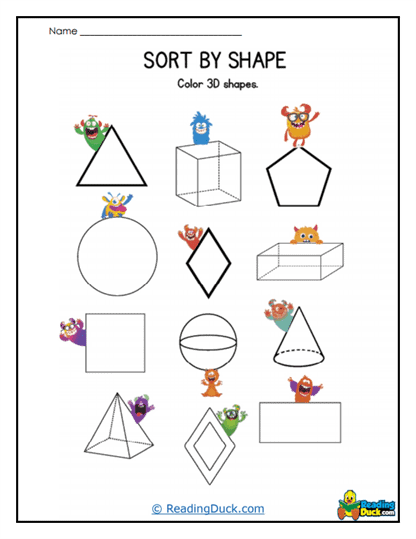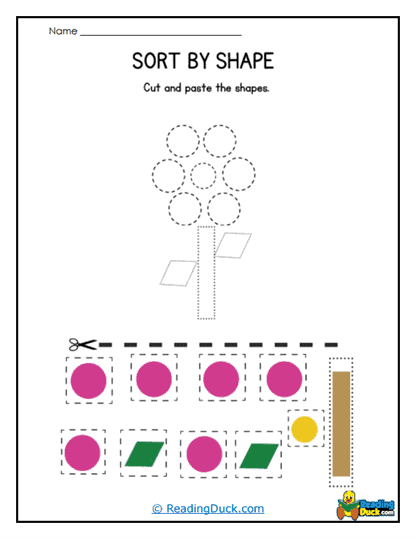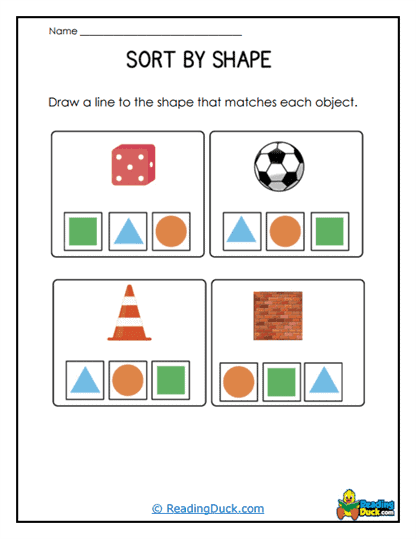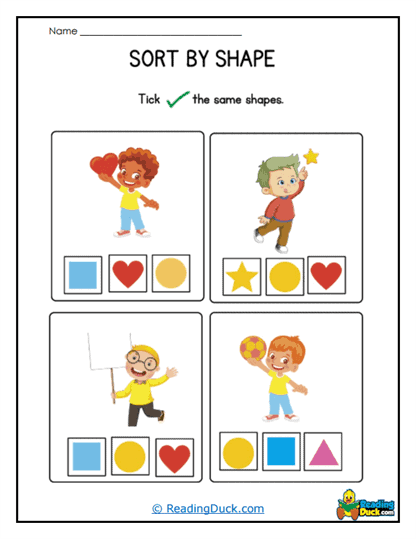Sort By Shape Worksheets
About Our Sort By Shape Worksheets
Our Sort By Shape worksheets bring learning to life in a way that is both exciting and educational. Each worksheet is crafted with visually appealing and engaging activities designed to capture students' curiosity and help them learn through play. From coloring and matching to sorting and categorizing, each activity introduces students to a new aspect of shape recognition, building their understanding step-by-step. The worksheets cover both 2D and 3D shapes, giving young learners a solid foundation in geometry concepts that will support their academic growth and understanding of the world around them.
One of the standout features of this collection is its wide variety of themes, which range from animals and everyday objects to familiar shapes and real-world items. These relatable themes make learning fun and accessible, helping students connect with the material on a personal level. When students see shapes that remind them of items they encounter every day, like circles in soccer balls or triangles in party hats, they’re more likely to engage with the activity and retain what they learn. The worksheets are carefully designed to resonate with young learners, making abstract geometry concepts feel concrete and meaningful.
The Sort By Shape worksheets are also created with flexibility in mind, offering different difficulty levels and a range of visuals to accommodate various learning stages and preferences. This adaptability is especially valuable for teachers and parents who can tailor the worksheets to each child’s unique pace and skill level, ensuring that every student is both challenged and encouraged. Whether a child is just beginning to recognize shapes or is ready to dive into complex sorting activities, the collection provides a versatile toolkit that grows alongside their abilities, supporting individual progress in a meaningful way.
These worksheets serve as a bridge between structured learning and creative expression, allowing students to explore, experiment, and enjoy the process of discovery. By balancing structured tasks with imaginative visuals, the worksheets foster an environment where students can build their skills while nurturing a love for learning. Through the act of sorting and categorizing, students not only master shapes but also develop broader cognitive skills, like critical thinking and problem-solving, which will benefit them in every area of their education.
Exercises on These Worksheets
Coloring by Shape
When students are given the task of identifying and coloring specific shapes, they’re doing much more than simply adding color to a page. This activity sharpens their shape recognition skills, prompting them to think critically about each form and follow precise instructions—a skill crucial for understanding patterns and sequences later on. As they choose the correct colors for each shape, students build spatial awareness, enhancing their ability to understand how shapes and spaces interact with one another. For teachers, this activity provides a dynamic way to blend creativity with learning, allowing students to build fine motor skills while fostering a sense of accomplishment through a colorful, finished product.
Matching and Sorting Shapes
Matching and sorting exercises encourage students to make connections between shapes and corresponding objects, teaching them essential categorization and classification skills. This practice helps students understand how to group and classify based on shared characteristics, which is foundational not only in geometry but also in advanced math, science, and even language arts. By recognizing patterns and similarities, students develop critical thinking skills, learning to organize information in meaningful ways. Teachers will appreciate how these activities foster structured thinking, a skill that aids students in making sense of complex information and recognizing relationships across subjects.
Identifying 3D Shapes
Introducing students to 3D shapes like cubes, spheres, and cones opens up a world of spatial understanding that bridges classroom concepts with real-world observations. Recognizing and naming these shapes builds their spatial intelligence, allowing them to identify 3D forms in the objects they see around them every day-like recognizing a cylinder in a can of soda or a sphere in a ball. This connection between worksheet shapes and tangible items makes learning more relevant, helping students understand how abstract concepts apply to their world. Teachers can use this activity to make geometry engaging and relatable, sparking curiosity in students as they begin to see how math exists in their daily lives.
Drawing Shapes
Practicing drawing shapes within a grid may seem simple, but it’s a powerful exercise in building hand-eye coordination and precision, skills that are foundational for writing, art, and technical subjects. As students carefully replicate shapes, they learn to control their movements with accuracy, boosting their fine motor skills and fostering an early sense of geometry and symmetry. This activity also encourages creative expression, as students gain confidence in creating their own shapes and patterns, exploring new ways to represent familiar forms. Teachers can use this exercise as both an artistic outlet and a technical skill-builder, making it a versatile tool that supports creative exploration while laying the groundwork for more advanced geometry.
Educational Skills Developed
These worksheets are designed not only to teach shapes but also to foster essential skills that support overall cognitive development. Here's a closer look at the key skills students build:
Attention to Detail
These worksheets are thoughtfully designed to sharpen students' ability to spot even the smallest differences and similarities in shapes, which is essential for developing a keen eye for detail. By engaging in activities that require them to differentiate between circles, squares, diamonds, and other shapes, students learn to slow down, focus, and observe with intention. This attention to detail doesn’t just stay within the realm of geometry—it spills over into every subject, helping students tackle complex tasks with accuracy, whether it's identifying punctuation in sentences or analyzing data in science. Teachers can use these exercises to foster a classroom culture of mindfulness, showing students the value of careful observation and precision, traits that are invaluable throughout their academic journeys.
Visual Memory
Each matching and recalling activity strengthens students' visual memory, training their brains to remember and recognize shapes as foundational symbols. This kind of visual recognition is a powerful tool, especially in subjects like reading and math, where students must recall letters, numbers, and patterns quickly and accurately. Visual memory plays a critical role in helping students follow instructions, identify patterns, and engage in multi-step processes, all of which are foundational skills across various learning areas. Teachers will appreciate how these worksheets can serve as an easy yet impactful method for reinforcing memory skills, which translates into faster, more confident learning in any subject area.
Concentration and Patience
Activities that involve sorting shapes and coloring within specific outlines are deceptively simple yet immensely powerful in building concentration and patience. As students work to complete these tasks, they develop the ability to sustain focus for longer periods, a skill that is essential not just for completing assignments but also for effective test-taking and group projects. These worksheets allow students to see the value in taking their time to complete tasks thoughtfully and with care, reinforcing a growth mindset that values process over immediate results. Teachers can use these activities to introduce discussions on perseverance and patience, equipping students with skills that will serve them well both in and out of the classroom.
Problem-Solving Skills
The act of sorting and categorizing shapes encourages students to think critically, identify patterns, and make decisions, all of which are core elements of problem-solving. These exercises introduce the concept of logical thinking in an approachable way, laying the groundwork for higher-level skills that students will later use in math, science, and technology. By working through these worksheets, students begin to understand the value of analyzing information, recognizing relationships between objects, and finding solutions—skills they can use to navigate everything from word problems to scientific experiments. Teachers will find that these worksheets not only make shape recognition enjoyable but also provide a solid foundation for developing analytical skills that will benefit students in future studies and real-world challenges.
Real World Applications
The skills acquired through this collection have broad, real-world applications that make them valuable beyond the classroom:
Observation Skills
Recognizing shapes and patterns goes beyond classroom learning; it's a foundational skill that students will use throughout their lives. Whether they’re reading maps, identifying safety symbols on the road, or making detailed observations in a science experiment, a keen eye for detail is invaluable. These worksheets help students practice this skill in a low-stress, enjoyable way, using familiar shapes and interactive activities to hone their observational abilities. For teachers, this means introducing a tool that not only reinforces geometry concepts but also encourages students to be more mindful, attentive, and aware of their surroundings-skills that will benefit them across subjects and beyond school.
Visual Memory and Recognition
Visual memory is a crucial cognitive skill that aids students in everything from recalling directions to remembering people’s faces and places they’ve been. By frequently practicing with shapes, students build the mental pathways that make it easier to recall visual information quickly and accurately, supporting better reading fluency and mathematical pattern recognition. These worksheets provide an engaging way to strengthen visual memory, using shape-matching and recall exercises to deepen students’ mental retention. Teachers can rely on these activities to help boost students' confidence and competence in all areas that require visual recall, making their overall learning experience smoother and more enjoyable.
Patience and Concentration
In a world of constant distractions, the ability to focus on one task is more valuable than ever, and this skill often needs active cultivation in young learners. Through these worksheets, students practice sustained attention by focusing on coloring within lines, sorting shapes carefully, and completing each task thoughtfully. This process-oriented learning helps students understand the benefits of taking their time, which translates to better focus during test-taking, reading comprehension, and project-based work. For teachers, these worksheets provide an accessible way to introduce students to the concept of "mindful learning," helping them develop patience and perseverance-traits that lead to academic success and personal growth.
Problem-Solving Skills
Sorting and categorizing shapes might seem like simple tasks, but they’re powerful tools for building a foundation in logical thinking and decision-making. By engaging in these activities, students learn to identify patterns, make connections, and think critically about how shapes relate to one another, all of which are essential for subjects like math, science, and coding. These worksheets offer a gentle introduction to problem-solving, giving students opportunities to explore solutions in a safe and structured environment. For teachers, this means having a resource that not only teaches shape recognition but also encourages analytical thinking, helping students develop cognitive skills that will support their academic journey and real-world problem-solving abilities.









